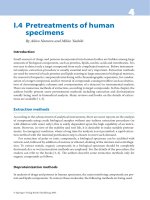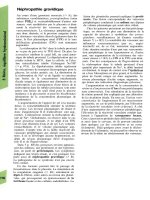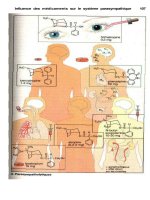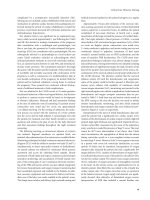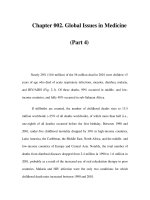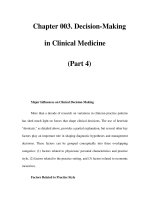Chapter 013. Chest Discomfort (Part 4) doc
Bạn đang xem bản rút gọn của tài liệu. Xem và tải ngay bản đầy đủ của tài liệu tại đây (13.03 KB, 5 trang )
Chapter 013. Chest Discomfort
(Part 4)
Pulmonary Embolism
(See also Chap. 256) Chest pain due to pulmonary embolism is believed to
be due to distention of the pulmonary artery or infarction of a segment of the lung
adjacent to the pleura.
Massive pulmonary emboli may lead to substernal pain that is suggestive of
acute myocardial infarction. More commonly, smaller emboli lead to focal
pulmonary infarctions that cause pain that is lateral and pleuritic. Associated
symptoms include dyspnea and, occasionally, hemoptysis. Tachycardia is usually
present. Although not always present, certain characteristic ECG changes can
support the diagnosis.
Pneumothorax
(See also Chap. 257) Sudden onset of pleuritic chest pain and respiratory
distress should lead to consideration of spontaneous pneumothorax, as well as
pulmonary embolism. Such events may occur without a precipitating event in
persons without lung disease, or as a consequence of underlying lung disorders.
Pneumonia or Pleuritis
(See also Chaps. 251 and 257) Lung diseases that damage and cause
inflammation of the pleura of the lung usually cause a sharp, knifelike pain that is
aggravated by inspiration or coughing.
Gastrointestinal Conditions
(See also Chap. 286) Esophageal pain from acid reflux from the stomach,
spasm, obstruction, or injury can be difficult to discern from myocardial
syndromes. Acid reflux typically causes a deep burning discomfort that may be
exacerbated by alcohol, aspirin, or some foods; this discomfort is often relieved by
antacid or other acid-reducing therapies. Acid reflux tends to be exacerbated by
lying down and may be worse in early morning when the stomach is empty of
food that might otherwise absorb gastric acid.
Esophageal spasm may occur in the presence or absence of acid reflux and
leads to a squeezing pain indistinguishable from angina. Prompt relief of
esophageal spasm is often provided by antianginal therapies such as sublingual
nifedipine, further promoting confusion between these syndromes. Chest pain can
also result from injury to the esophagus, such as a Mallory-Weiss tear caused by
severe vomiting.
Chest pain can result from diseases of the gastrointestinal tract below the
diaphragm, including peptic ulcer disease, biliary disease, and pancreatitis. These
conditions usually cause abdominal pain as well as chest discomfort; symptoms
are not likely to be associated with exertion.
The pain of ulcer disease typically occurs 60 to 90 min after meals, when
postprandial acid production is no longer neutralized by food in the stomach.
Cholecystitis usually causes a pain that is described as aching, occurring an hour
or more after meals.
Neuromusculoskeletal Conditions
Cervical disk disease can cause chest pain by compression of nerve roots.
Pain in a dermatomal distribution can also be caused by intercostal muscle cramps
or by herpes zoster. Chest pain symptoms due to herpes zoster may occur before
skin lesions are apparent.
Costochondral and chondrosternal syndromes are the most common causes
of anterior chest musculoskeletal pain. Only occasionally are physical signs of
costochondritis such as swelling, redness, and warmth (Tietze's syndrome) present.
The pain of such syndromes is usually fleeting and sharp, but some patients
experience a dull ache that lasts for hours. Direct pressure on the chondrosternal
and costochondral junctions may reproduce the pain from these and other
musculoskeletal syndromes. Arthritis of the shoulder and spine and bursitis may
also cause chest pain. Some patients who have these conditions and myocardial
ischemia blur and confuse symptoms of these syndromes.
Emotional and Psychiatric Conditions
As many as 10% of patients who present to emergency departments with
acute chest discomfort have panic disorder or other emotional conditions. The
symptoms in these populations are highly variable, but frequently the discomfort is
described as visceral tightness or aching that lasts more than 30 min. Some
patients offer other atypical descriptions, such as pain that is fleeting, sharp, and/or
localized to a small region.
The ECG in patients with emotional conditions may be difficult to interpret
if hyperventilation causes ST-T-wave abnormalities. A careful history may elicit
clues of depression, prior panic attacks, somatization, agoraphobia, or other
phobias.
